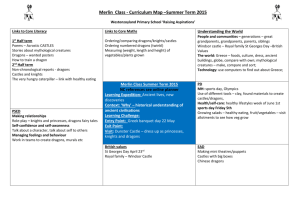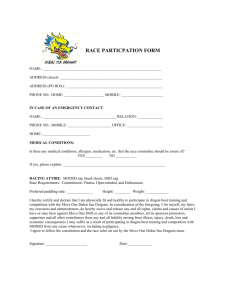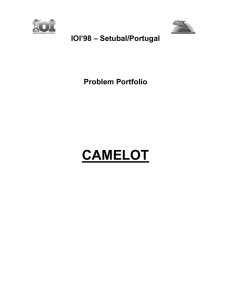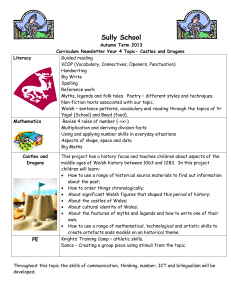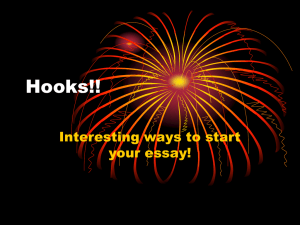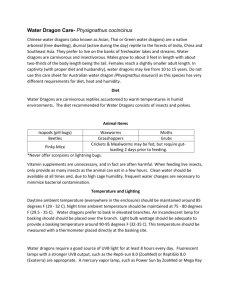THE DRAGONS 1 - Random House Australia
advertisement
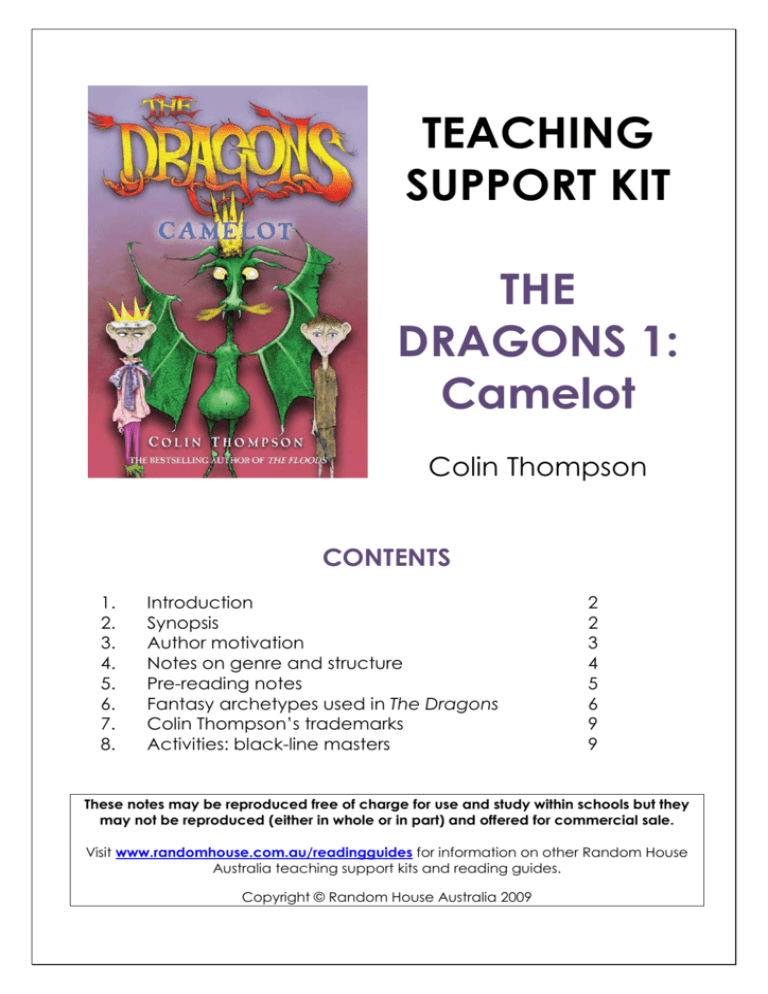
TEACHING SUPPORT KIT THE DRAGONS 1: Camelot Colin Thompson CONTENTS 1. 2. 3. 4. 5. 6. 7. 8. Introduction Synopsis Author motivation Notes on genre and structure Pre-reading notes Fantasy archetypes used in The Dragons Colin Thompson’s trademarks Activities: black-line masters 2 2 3 4 5 6 9 9 These notes may be reproduced free of charge for use and study within schools but they may not be reproduced (either in whole or in part) and offered for commercial sale. Visit www.randomhouse.com.au/readingguides for information on other Random House Australia teaching support kits and reading guides. Copyright © Random House Australia 2009 INTRODUCTION In the days when dragons roamed the earth turning people into toast, a mighty King ruled the world. This King lived in the great castle of Camelot in the beautiful island of Avalon. Guided by the great wizard Merlin, this King became a legend and his name was Arthur. The trouble with legends is that every time their stories are told they become more and more fabulous, so useless twits are often turned into superheroes. This is the true story of King Arthur, who was not a superhero. He was a nasty little spoilt brat who was totally up himself. Or was he . . .? In his new series The Dragons, bestselling and multi-award-winning children’s author Colin Thompson takes on two of the most beloved myths of the fantasy world – dragons and King Arthur. The legends of Camelot will never be the same. SYNOPSIS Long ago in a faraway land, nearly halfway between somewhere over the rainbow and 23 Paradise Street, Arcadia, was a magical land called Avalon. At the heart of Avalon was a magical castle called Camelot. And at the heart of Camelot lived a mighty King called Uther-Pendragon. That is, until the King’s son, Arthur, discovers that being King allows you to eat pheasant off a plate, with a knife and fork, instead of eating gruel flavoured with goat’s hoof from a wooden bowl. Best of all, being King allows you to eat BACON. Arthur’s decision is made. ‘Daddy must become dead,’ he whispers into the darkness. Merlin, the greatest wizard in the land, has a terrible premonition about the King’s soon-tobecome-dead situation, but no one will listen. So with a helping hand from Arthur’s nana, the great King Uther-Pendragon dies, the complete idiot boy Arthur becomes King and the Dark Ages begins. Being King isn’t as much fun as King Arthur expected. For one thing, there are the bubbles exploding in the toilet bowl. Arthur knows what’s causing them: dragon breath. And when throwing explosives down the toilet causes all the drains in Camelot to become blocked, the result is intolerable. Someone has to go into the dragon caves to unblock Camelot’s drains. But whoever does so is guaranteed to become dragon breakfast, aka toast. King Arthur decides to send four messengers to the farthest corners of the Kingdom, to find and bring back a Brave Knight who will save the day (and not ask too many questions). TEACHING SUPPORT KIT The Dragons 1: Camelot 2 Meanwhile, Spikeweed, King of the Dragons (well, King of the five dragons who are left in Camelot), is angry. ‘Roarin’ thumbs!’ he swears. If only dragons had opposable thumbs, they would be ruling the world, not stuck in a damp cave that smells like old dragon wee because of his ancient granny, Gorella. His wife, Primrose, isn’t happy either. And their kids, Bloat and Depressyng, are so bored that they have to resort to blowing bubbles into the toilets of Camelot. Is there a way that the dragons can rebuild their numbers and take back what’s rightfully theirs? In another meanwhile, the King’s sister, Lady Morgan le Fey (more beautiful than a bucketful of chocolate, more clever than a whole box of very clever owls yet wonderfully modest), is also angry. The King has promised her hand in marriage to the Brave Knight who can slay the dragons, but that is not going to happen if she has any say in the matter. When Morgan le Fey discovers that there is a boy working in the kitchens who is fireproof (do you see a crafty link forming here?), she hatches a plan. She must find this boy and verify his amazing ability. And then – well, let’s just say that nasty King Arthur and his pretty mauve tights may not be sitting on the throne for much longer . . . AUTHOR MOTIVATION Colin Thompson says: There is no reliable evidence to prove King Arthur actually existed. So everything you read about him and the legendary Knights of the Round Table has all been made up, most of it written hundreds of years after it was supposed to have happened. And most of these books are long-winded and boring. Nearly all of the modern stuff written about King Arthur is melodramatic and very pretentious and boring too. However, in among all this, there’s a lot of great material. It just needed re-writing properly so modern readers can learn the truth about the toilets of Camelot. On the other hand, dragons are not made up. Everyone knows that they were real and, in fact, there are probably small colonies of them still surviving in remote parts of South America and Tasmania.1 There are various theories about how dragons became extinct, the most likely of which was put forward by my daughter Hannah when she was five years old: ‘Granny ran them all over.’2 Of course, you can choose which King Arthur and which dragon books you believe are true, but if don’t choose mine, you will be wrong. That is why I am writing this series: because it is time that the world knew the accurate truth about these things. In Tasmania there is a group of dragons in a hidden valley who have domesticated Tasmanian Tigers and keep them as pets. 2 My mother was a Really Bad Driver. 1 TEACHING SUPPORT KIT The Dragons 1: Camelot 3 NOTES ON GENRE AND STRUCTURE Genre The Dragons crosses fantasy with humour. Using the myths and legends surrounding Arthurian times and dragons, Colin creates an alternate version of events – a parody of other genres. The Macquarie Dictionary defines parody as: ‘a humorous or satirical imitation of a serious piece of literature or writing.’ Classroom discussion question: What other parodies have students read or seen? Examples might include: Colin’s series The Floods (a parody of witch and wizard fantasy); William Goldman’s novel and film The Princess Bride parodies fantasy conventions such as pirates and princesses; Terry Pratchett’s Discworld novels parody real-world activities and places such as newspaper publishing or universities; Mad Magazine often parodies films and TV shows; TV shows such as The Simpsons parody real events or characters. Activity: Have students define the elements of parody they find in these examples (such as silly names, puns, a plot twist on a traditional story) and write a parody of their own. Structure The Dragons 1: Camelot has a complex structure due to the large number of characters. It begins with a broad overview of the setting, describing the beautiful land of Avalon and the magical castle called Camelot. Subsequent chapters then introduce readers to the various main characters: young Prince Arthur; his parents King Uther-Pendragon and Queen Igraine; the Top Wizard Merlin; the dragon family comprising Spikeweed, Primrose, Bloat, Depressying and Gorella; the young orphan Romeo Crick; and Arthur’s sister Morgan le Fey. The book then alternates chapters to describe what is happening in the lives of Arthur, the dragons, Romeo, and Lady Morgan le Fey. There are also chapters where readers find out what has happened to the four messengers sent to find a Brave Knight. By the climax and resolution of the novel, readers find out how the lives of the various characters intersect, and all the characters appear in the same chapter. Classroom discussion questions: elements of a story • What problem or conflict is introduced, which must be solved in the story? (Answer: There are two problems: (1) The wrong person is on the throne. (2) The toilets of Camelot are blocked up and someone has to fix them.) • What do students think is the main plot or story in The Dragons 1: Camelot? (Is it the first or second of the problems mentioned above?) What are the subplots or less important storylines? Is it easy to identify the main plot? • What is the climax of the story, when the problems or conflicts are resolved? (Answer: When Romeo goes into the dragons’ cave.) What events lead up to the climax? What events had to happen so that the climax could take place? (Example answers: the messengers had to find and bring back a Brave Knight; someone had to realise that Romeo was fireproof and could therefore safely enter the cave; Romeo had to be freed from the kitchens.) • What is the resolution of the story – what happens to the characters after the conflict is resolved? (Answer: The dragons and humans become allies.) TEACHING SUPPORT KIT The Dragons 1: Camelot 4 PRE-READING NOTES Because The Dragons 1: Camelot is a parody of existing Arthurian and dragon stories, students could familiarise themselves with other stories before they begin reading. Arthurian legends There are hundreds of versions of the Arthurian tales. The following summary of the key elements is from The Road to Camelot, a collection of short stories about the heroes and heroines of Arthurian legend: ‘The legend is huge, and comprises many, many stories, but the basic thread is this: a young orphaned boy named Arthur, who has been brought up by a fosterfather, Sir Ector, comes as a squire to his foster-brother Kay, to the court of the late King of Logres, Uther Pendragon. There sits a sword magically inserted into a stone, which can only be drawn by the one who will be king. Arthur draws it – and learns that he is actually the sond of Uther, and the next king. He also learns that he is under the protection of the great wizard Merlin, who is also a prophet, and who tells him of his strange birth, and of the fact that he has two half-sisters, Morgause and the enchantress Morgan . . . [Arthur] builds Camelot, the great city where all will know peace and prosperity. As well, he founds the Fellowship of the Round Table, where sit his companions, the greatest knights in all the world, who help him keep Camelot safe. Such knights as Gawain, Lancelot, Galahad, Tristan, Perceval, Bors, Kay and more join the Round Table. As well, Arthur is given a magic sword, Excalibur, by one of his Otherworldly friends, the Lady of the Lake.’ (Sophie Masson, ‘Introduction’ pp. 2–3, The Road to Camelot, Random House Australia, 2009) There is far more to the legends than this brief summary, including enchantments, doomed romance, dark secrets and the island of Avalon, where no one dies. Other books and sources of learning about Arthurian legend include: • Wikipedia information: http://en.wikipedia.org/wiki/King_arthur • Novels and stories: The Road to Camelot edited by Sophie Masson, the Arthur trilogy by Kevin Crossley-Holland, Here Lies Arthur by Philip Reeve, the Shalott trilogy by Felicity Pulman, Legends of King Arthur by Andrew Matthews, Sir Gawain and the Green Knight by Michael Morpurgo • Films: First Knight (1995), Monty Python and the Holy Grail (itself a parody) • TV series: Merlin (1998 miniseries); and Merlin (current BBC TV series about the young Arthur and Merlin) Dragon stories Dragons feature in the myths, legends and stories of various cultures around the world, from Europe to China. Here are some places to learn more about dragons: • Wikipedia information: http://en.wikipedia.org/wiki/Dragons • Novels and stories: Eragon by Christopher Paolini; the Dragonkeeper series by Carole Wilkinson; Deltora Quest 3 by Emily Rodda; Dragonrider by Cornelia Funke; The Fire Within by Chris D’Lacey; The Book of Dragons by E. Nesbit (short stories) • Illustrated books: Dragonology by Dr Ernest Drake; Discovery of Dragons by Graeme Base; check your library for books about mythical creatures TEACHING SUPPORT KIT The Dragons 1: Camelot 5 • • Films: Eragon; Dragonheart; Shrek; Pete’s Dragon; Mulan TV series: Merlin (current BBC TV series) Pre-reading activities: • • • Make a list of what you know about King Arthur and Camelot before reading the book. Make a list of what you know about dragons before reading the book. Draw a dragon. FANTASY ARCHETYPES USED IN THE DRAGONS The following table lists some of the archetypes that are twisted into another form in The Dragons 1: Camelot for humorous effect. Most are subverted for the purpose of parody, but readers will find that some archetypes are also upheld for dramatic effect – for instance, the quest is ultimately fulfilled and the unlikely hero eventually wins the day. What is an archetype? In stories the archetype is the original model, or ideal example, which is then copied by others. Archetypes in fiction have sometimes developed over hundreds of years, through folklore, myths and legends. Some examples of character archetypes are: the hero; the scapegoat; the noble knight; the wise guide or mentor; the evil villain. Some examples of situation and symbol archetypes are: the quest; the journey; the forest or garden; trial or imprisonment; transformation; magic potion; the omen or prophecy; the task or test; the battle between good and evil. You can find more information about archetypes and tropes online. For instance, http://tvtropes.org/ has plenty of information and examples of many of the archetypes featured below. Archetype The Dragons 1: Camelot version The hero We think that Prince Arthur is the hero because the book begins from his perspective, but actually it is Romeo Crick, the kitchen boy, who is the hero of the story. Although it parodies the idea of the hero in some ways, The Dragons 1: Camelot also adheres to convention because Romeo Crick is an unlikely hero – an orphan who is delivered via a basket in the river, and who turns out to have special powers (he is fireproof). The wise guide or mentor / The wizard Merlin conforms to the archetype of the wise wizard in some ways, but not in others. He has premonitions (p 20). He says he lives to serve the King, but he ‘actually only lived to serve Merlin’ (p 22). ‘Merlin was the most magical person in the Kingdom, the only true wizard, though his talents in that direction were not so much based on him being a mystical superhero as the fact that he was the owner of the only copy of The Wizard’s Big Book of Spells.’ (p 26) He pretends to flatter Arthur, but he’s been controlling the Kingdom for a long time. TEACHING SUPPORT KIT The Dragons 1: Camelot 6 The noble or brave knight Colin Thompson definitely parodies the idea of the noble and brave knight. Of the four Royal Messenger knights described in the book: 1. Sir Barkworth is ‘stupid’ (p 111), and his title was won in a raffle; ‘A more useless person to send out on a quest was hard to imagine.’ (p 112) 2. Lord Pleat of Perivale is ‘reluctant’ and ‘afraid of travelling’ (p 139). In fact, he is afraid of everything. 3. Sir Lamorak seems to be the ideal knight: he is ‘really keen on the mission’ and races toward his destination. However, he meets a terrible end very quickly, proving that being keen and determined doesn’t always win the day (p 153). 4. Sir Bedivere is ‘totally unscrupulous’ (p 167) and nasty. Thompson says he is like Robin Hood or Ned Kelly, ‘common criminals with very good public relations’ (p 170). The Brave Knights who Sir Barkworth meets on pages 119 to 121 sound more like those of legend, but they are unwilling to undertake the quest and task required and make excuses. On the other hand, Sir Lancelot does conform to many of the ‘noble knight’ characteristics: he is brave, strong and handsome. He has been on a quest, where he ‘lanced a lot of Heathen Goths’ and ‘slayed Vlad the Inhaler’ (p 172). He is keen to ‘win the hand’ of the princess, Morgan le Fey. However, Thompson parodies him by having him deceived by Sir Lamorak and fleeced of all his money. He also has Morgan le Fey reading an article about him in Handsome Knights Monthly, which parodies the modern-day culture of celebrity by setting knights up as material for gossip. The evil villain Who is the villain in The Dragons 1: Camelot? There are several contenders, but Thompson subverts our expectations of each one. We think the dragons could be the evil characters, but then we see that they’re quite pathetic – the only dragons left, who complain and moan about how powerful they could have been if only they had thumbs. Thompson could have made Merlin or Morgan le Fey the evil villains of the piece – after all, they want power and control. But in the end they help the situation. The most villainous person is perhaps Arthur himself, who is not so much evil as vain, spoilt and stupid (p 41). The quest The main characters don’t go on a quest but four messengers are sent to the four corners of the Kingdom to find a Brave Knight. Their missions are variously unsuccessful, whether through stupidity or greed or bad luck – thus subverting the usual quest fantasy story. The forest or garden The first chapter describes the beauty and majesty of the magical land of Avalon. Thus the book begins quite traditionally, setting the story within a traditional, idyllic fantasy setting. However, the story soon begins to diverge from this picture of perfection: we learn that the creatures of the moat have evolved into snails with razor-sharp spikes and ‘the mind-numbingly vicious bacteria evolved into . . . clerical staff’. We find out that the toilets are blocked, that there is an attic full of nanas, and that hundreds of years later, the land ‘became, once again, a damp windswept place full of miserable ignorant Celts’ (p 82). TEACHING SUPPORT KIT The Dragons 1: Camelot 7 Trial or imprisonment Transformation Romeo Crick endures trial by fire as he is asked to clean the ovens in the kitchen – he survives because he is fireproof. King Arthur imprisons his mother, Queen Igraine, on an island with only one servant. She comes to a bad end after she’s forgotten by everyone. In this way the book upholds the archetype: the unlikely hero, Romeo, is transformed in a ‘rags to royalty’ scenario from a lowly kitchen servant wearing rags to become the King of Avalon. The false King, Arthur, is imprisoned and humiliated as punishment for his vanity. The dragon of archetype is often majestic, with huge wings, a hoard of gold and treasure, and a noble bearing, often coupled with a disregard for humans. Dragons Here Thompson completely subverts the archetype – as you can see from the cover, his dragons are scrawny, with tiny wings and pot bellies. They can hardly fly – in fact, a whole chapter is devoted to describing the children’s attempts to learn to fly, with resulting injuries. Spikeweed has no treasure – he lives in a damp cave that smells of wee because of his old Granny, Gorella. Rather than being noble, he and his wife complain and bicker constantly, wishing that the dragons could be powerful again but knowing that it’s their lack of opposable thumbs that keeps them from bettering their situation. The story does parallel the more standard archetype, where the hero must enter the dragon’s lair to find and retrieve a treasured item – but in this case the hero must enter to leave sticks of dynamite to explode the blocked drains. The Round Table Thompson’s version of what happens to King Arthur’s Round Table is hilarious. Read pages 154 to 165 to find out how the most amazingly beautiful table ever created becomes the Great Round Pepper Pot Stand. Birthmarks or scars are a standard symbol of greatness or power in fantasy fiction, from Harry Potter’s lightning-shaped scar to the birthmark that marks the child of prophecy in the book and film Willow by George Lucas. The distinguishing mark Switched at birth The Dragons 1: Camelot is no exception, with Morgan le Fey and Merlin being able to tell the true King by a birthmark on his back, ‘the Mark of the King’. The birthmark is not shaped like a crown but like a fish. Although Thompson makes light of this, with Romeo thinking it was ‘the Curse of the Haddock’ (p 205), it actually reflects another Arthurian legend: that of the Fisher King. Romeo’s hidden birthright also fits with the ‘Moses in the bullrushes’ archetype – he is found in the river, though in a ‘wicked basket’ rather than the usual wicker. This is a result of another fantasy trope – that of being switched at birth. TEACHING SUPPORT KIT The Dragons 1: Camelot 8 Activities: • Research opposable thumbs. (Try http://en.wikipedia.org/wiki/Thumb) Which animals have them? What are the benefits? How have opposable thumbs affected the evolution of humans and animals throughout history? (Try reading a book or writing something without using your thumbs.) Is Spikeweed right when he says that creatures with opposable thumbs are destined to be the most powerful? • Write a story featuring at least three of the above archetypes. COLIN THOMPSON’S TRADEMARKS Fans of Colin Thompson’s work will find that certain symbols, characters and themes recur in his books, from the most serious to the silliest. Here are a few that you can spot: • • • • • Spies – in The Floods the spies are a bumbling trio. In The Dragons they are cockroaches who spy on everybody for everybody. Whippets – You can always find a yellow window with a silhouette of a whippet on the spine of The Dragons and The Floods – this is Max, Colin’s own whippet. The Dragons also has a character called Fremsley the Royal Whippet – who is mentioned several times but never appears in the story (though a ‘Post-postscript’ on page 230 tells us that he will feature more in the next book). Colin’s picture books often feature dogs, such as The Big Little Book of Happy Sadness. For more information about Colin’s dogs go to: http://www.colinthompson.com/page6.htm Nanas/old ladies – compare the nanas in The Dragons (see pp 7–16) with Quenelle in The Floods 7: Top Gear or Auntie Mould in The Floods 8: Better Homes & Gardens, the immortal old woman Bathline in How to Live Forever, or the old lady the family adopts in Free to a Good Home. Love stories – there is often a love story in Colin’s books. In The Dragons it is hinted that Romeo and Lady Petaluna may fall in love when they are older. Morgan le Fey also finds love with the Brave Knight Lancelot. Footnotes – it wouldn’t be a Colin Thompson book without footnotes that add extra information about aspects of the text. These often pull the reader out of the fictional story by mentioning how the story relates to the real world – for instance, on page 3 the footnote tells readers that olms are real. (You can find information about olms at: http://en.wikipedia.org/wiki/Olm) Classroom discussion questions and activities: • Discuss the footnotes in The Dragons. Do students like them because they add extra information, or do they find that the footnotes make them lose their place in the story? What other books have they read that feature footnotes? • Extension students could look at the metafiction aspects of The Dragons, such as: the footnotes that talk about how the fictional elements relate to the real world (eg p 3); the footnotes with asides about Colin’s own life and family (eg p 50 or p 89); mentions of current TV shows (eg Colin spoofs Australia’s Got Talent). See http://en.wikipedia.org/wiki/Metafiction for information about metafiction. BLACK-LINE MASTERS: ACTIVITIES Some photocopiable activities are included on the following pages. TEACHING SUPPORT KIT The Dragons 1: Camelot 9 BLACK-LINE MASTER AVALON ADVERTISEMENT Look at the ads on pages 17, 79, 85, 177 and 215. In the space below, create your own advertisement for a product or place in Avalon. You could make up your own, or try advertising the magazine Handsome Knights Monthly (see p 104), the book The Wizard’s Big Book of Spells (see pp 26–27), or the Environmentally Friendly Bucket Shop (p 55). TEACHING SUPPORT KIT The Dragons 1: Camelot 10 BLACK-LINE MASTER Fantasy archetypes in The Dragons In stories the archetype is the original model, or ideal example, which is copied by others. Fictional archetypes develop over hundreds of years, through folklore, myths and legends. The table below lists some archetypes used or parodied in The Dragons. Fill in the columns: (1) Name a book, TV show or film you have seen that makes use of that archetype. (2) Name the character, situation or symbol used in The Dragons to represent that archetype. (The first two archetypes have been filled in for you as examples.) Archetype (1) Where I’ve seen it used (2) How The Dragons uses it The unlikely hero • Luke Skywalker in Star Wars • Will in Ranger’s Apprentice Romeo Crick The wise guide / The wizard • Gandalf in Lord of the Rings Merlin The noble or brave knight The villain The quest Transformation from ‘rags to riches’ Dragons The distinguishing mark (birthmark or scar) TEACHING SUPPORT KIT The Dragons 1: Camelot 11
